Signage. It’s a part of our daily lives. It’s the visuals that guides us in times of need. In unfamiliar locations they help inform us, alleviating the reliance of poking at numerous strangers. In our every day lives, they tend to fade into the backdrop, becoming a patch on a wall we no longer pay much attention to. Some merely serve their function to inform, while others alter their form to entice.
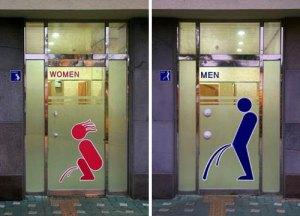
via foundshit.com
Signage dates back to ancient Rome, when they were typically handcrafted of stone or terracotta. In 14th century England, water wasn’t typically safe to drink, so signs were required to be hung outside of ale houses to advertise where to quench your thirst. By the 16th and 17th centuries, the appeal of signage was taken to a new level with some of the greatest artists of the time creating very elaborate and intricate designs, some of which are still displayed in our museums today.

via britannica.com
Although the visually-pleasing displays can naturally lure us towards them, signage indeed functions properly without it. The function plainly serves to deliver information, direction, identification, and safety and regulations. The aesthetics are just an added bonus for the eyes of the consumer and the pocket of the producer.
However, in my current location, there has come a time when this daily feature has become so overbearing that not only its form, but also its function has been stripped away completely, leaving people not informed or delighted, but instead extremely confused and exasperated.
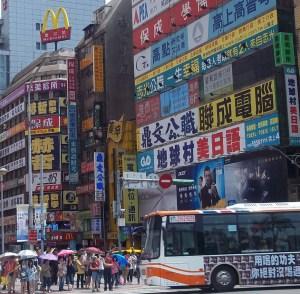
Taipei
Before arriving in Taipei, I had seen images of Asian cities and their facades of neon lights and massive billboards that cover half of entire buildings. So when I arrived in Taiwan at 7am after an almost 24 hour trip from home, the signage didn’t phase me too much, it was almost expected. Now, after living here for almost two years and traveling back here from dissimilar places, I’ve taken the time to reflect on the overwhelming nature of this everyday object.
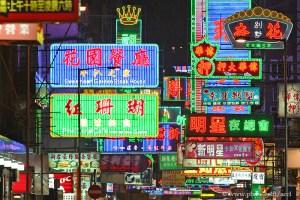
Hong Kong, via theskyscrapercity.com
In Taipei, it’s rare to actually see the face of a building. Most buildings are multipurpose, with a store front on the ground level and either offices or residences above. Most of these buildings, from what I am able to observe, look exactly the same; constructed of some sort of stone or tile to prevent from withering away at the harsh tropical climate. Cladding these cloned structures are various colors, shapes and sizes of sign, after sign, after sign. Signs displaying different varieties of food, signs displaying various English-speaking schools, signs advertising product after product, housing complex after housing complex, model after model. With nothing but signs in my distant vision, how is any one supposed to grab my attention?
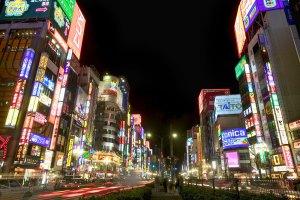
Tokyo, via http://cdn.lightgalleries.net
When meeting friends at an unfamiliar restaurant, I attempt to peer through and beyond all of the neon words, characters and images to find the destination I’m looking for. When trying to find a doctor, I have the challenge of staring at a great wall of poster boards trying to find the specific doctor I researched for my specific need. When looking for a map or directional information, I play a game of ‘frogger‘ amongst the crowds of people flowing in each and every direction trying to find the correct informational sign. With sign after sign screaming in your face and begging for you to follow, it’s nearly impossible to focus on what you were originally looking for.
The layers upon layers of signage, which hide buildings’ skin and illuminate the residences and offices of those who occupy, have eaten away at the function they were originally intended to serve and the form they could have potentially served. The most successful and inviting places I’ve come across in Taipei have been those that are tucked away in an alley, allowing for their own space to shine and greet and not being met with the competition that bigger is better. Some of these charming locations don’t require beautiful signage, but instead create their reputation through their own specialties and a handwritten sign taped to the front window. Some indeed are inviting due to their beautiful displays, which, among the larger roads, would most likely be left unnoticed.
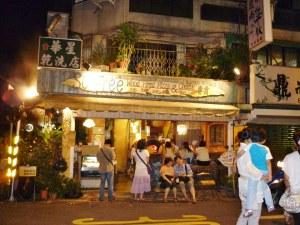
So Free Pizza, Taipei, via http://www.hungryangmo.com
There are indeed examples of places that handle their signage tastefully, even in its abundance. Times Square, for example, can be compared to an Asian city with its plethora of displays that make you feel miniscule in their presence. However, within New York City, this is the only area that is loud and flamboyant in this manner. In Taipei, and other large Asian cities, this is nearly impossible to escape.
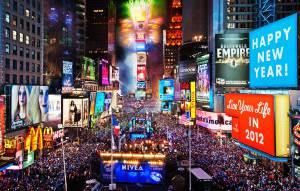
via media2.policymic.com
Now’s the time to look back to the basic function of the sign and pepper in the special artistic attention when desired. Sure, the bright lights may lure you in wide-eyed like a deer in headlights, but for this to surround your daily life, it’s incredibly distracting and unimpressive. These signage-cladded cities must step back and realize that one, bigger is not better, and two, everything is OK in moderation.
___________________________
Do you know of another city that is immensely signage-happy? What about a city that knows how to appropriately display these pieces of information? Share below:

